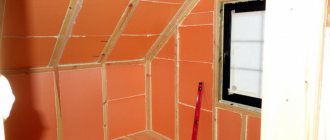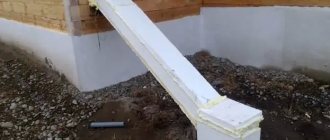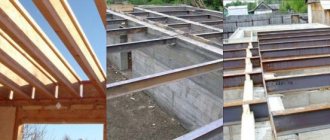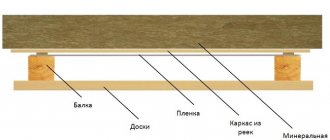Flooring with wooden beams is a load-bearing structure that separates adjacent rooms: floors, attic, underground. When constructing it, factors such as load-bearing capacity, sound and heat insulation, seismic resistance and heat resistance are taken into account. This structure regularly experiences loads and atmospheric influences, so it must meet the criteria of strength and wear resistance. According to their purpose, floors are classified into basement, interfloor and attic.
Types of floors
A floor is a horizontal load-bearing structure made of beams that divides a building in height into functional zones or floors and maintains the strength of the entire structure. When building a house, the following types of floors are used:
- basement or basement floor;
- interfloor covering;
- attic floor.
Attic floor
Naturally, the most durable are metal beams in the form of a channel, angle or I-beam, made of high-strength steel. They are best used for the basement floor, as it bears the greatest load. Steel beams can be used to create long spans with large distances between beams. They are resistant to mechanical damage and rotting. However, due to their heavy weight, they are difficult to work with, and the high price of the metal increases construction costs.
Reinforced concrete floor beams can withstand heavy loads and are suitable for the construction of multi-story buildings. But for their installation you will need special equipment.
Basically, in the construction of private houses, wooden beams are used for floors. Wood is a reliable and environmentally friendly material that will not harm the residents of the house. Wooden beams are relatively inexpensive and light in weight compared to previous types, so they are easy to install. However, the tree is flammable, susceptible to rotting and bark beetle damage, and therefore requires pre-treatment.
The importance of vapor barrier and methods of its installation
Vapor barrier of the attic floor ensures the safety of the wooden floor. It extends the life of the roof, helps create an optimal microclimate in residential premises, removing excess moisture, and prevents heat loss. You should choose the material for vapor barrier carefully, without any intention of saving money.
Vapor barrier material has different side structures. On one side, the rough surface absorbs moisture, the other side with a film prevents moisture from penetrating into the heat-insulating layer.
The vapor barrier is installed, as is already clear, between the ceiling and the insulation in the attic floors. Materials used:
- polyethylene;
- polypropylene.
Fabrics reinforced with a special mesh may have perforations. You can also use non-perforated film, leaving gaps during installation. The reinforced film has a metallized surface. The film is spread downwards with the metallized surface to reflect heat loss.
A layer consisting of fibers absorbs moisture, then evaporates it naturally. The materials are durable and resistant to ultraviolet rays.
There are also other vapor barrier materials that can be used when equipping the attic floor with wooden beams as a vapor barrier. These are varnishes and mastics, asphalt, bitumen, bitumen-kukersol. Today, such materials are rarely used, preferring non-woven fabrics of synthetic origin. These are so-called “breathable membranes”, capable of transmitting moisture and air, multi-layer, single-layer, equipped with aluminum foil.
The material is placed with a 20 cm overlap on the wall, secured with a stapler, the rough side down.
Video on the topic:
Types of Wood Beams
Wooden beams vary in size, cross-section, production method and type of wood from which they are made. The reliability and strength of the structure depends on the choice of wooden beams. Depending on the distance between the walls and the expected load for the floors, use a board or beam made of solid wood, or glued products.
Types of wooden beams
Solid beams
Beams made from solid wood are less durable than glued or I-beams. Therefore, their length should not exceed 6 meters. Often, to increase strength, builders on site pair boards. They are tightened with bolts and nuts with rubber or plastic gaskets that prevent moisture from entering and rust forming on the fasteners.
Glued laminated timber
Glued laminated timber is made by gluing several parts together. Beams made of this material can withstand high loads, so they can be used in the construction of floors up to 14 meters long. From such timber you can make bent floors for arches.
Such products also have disadvantages. Low-quality lumber may be used in manufacturing, so the beam floor may shrink over time. In addition, glued beams are much more expensive than solid ones. In order to more efficiently use the funds allocated for construction, you need to correctly calculate the load and length of the beams.
Glued laminated timber with a similar cross-section to conventional timber has greater strength
Floor beams are made from coniferous wood, but oak, acacia, maple and other trees are also often used. The main condition necessary for the strength of the structure is humidity no more than 12–14%. Types of some products are shown in the table below.
I-beams
The advantages of I-beams are versatility of use, ease of installation and high strength. They retain their parameters under heavy loads without auxiliary structures for reinforcement.
I-beam device
I-beams are made using well-dried planed or laminated timber, durable glued waterproof plywood or OSB boards, based on fire-resistant and moisture-resistant glue. Therefore, an I-beam wooden beam does not require impregnation with special compounds and can be easily sawed. However, due to the complex manufacturing technology, they are rarely used for flooring.
I-beams made of OSB (OSB)
Connecting I-beams to each other
All types of products have their own assortment. An assortment is a selection of various finished products by brand, profile or size. Often the table will include additional information about strength, weight, etc.
Section of beam floors
The strength of the floor is also affected by the section of the beam. By type of section the following types of lumber are included:
- rectangular;
- square;
- round;
- oval;
- I-beam
The most common are rectangular beam floors. They are easy to install and such beams will serve as lags for arranging floors. When installing rectangular beams, they are installed vertically with the wide part, since the strength of the structure increases with increasing height.
For attic floors, round beams or rounded logs are often used. Such beams have good strength and resistance to deflection.
The strongest and most functional are I-beams.
Calculation of the load and dimensions of wooden beams
Before erecting a building, it is necessary to calculate the load and length of the beam floors. For better floor strength during construction, you need to use wooden beams with a slightly larger safety margin than the calculated one.
Selecting the width or thickness of the beam depending on the length
To correctly calculate the load on a floor beam, you need to:
- Know the distance between walls and the pitch between beams.
- Calculate the constant load consisting of the mass of beams, insulation and materials from which the floor and ceiling are made.
To calculate, you need to add the specific gravity per square meter. meter of all building materials
- Temporary load. This includes the mass of furniture and people in the building. As a rule, it is considered equal to 150 kg/m2.
- Calculate the expected load per 1 m2 of flooring (sum of temporary and permanent indicators).
Since the calculation requires knowing the load per linear meter, you need to multiply the estimated load per 1 m2 by the distance between the beams. Next, the resulting figure is multiplied by the square of the distance between the load-bearing walls and divided by 8. This is how the load of the beam floor is calculated.
Mmax = (q*L2)/8
Where:
- q - full load per sq. m;
- L2 is the square of the distance between the walls.
When designing a floor frame, you need to pay attention to spatial rigidity, which largely depends on the deflection rates of the beam floor.
The calculation of a wooden beam for deflection is carried out according to the formula: W = Mmax / R , where M is the maximum load, and R is the resistance of wood from SP 64.13330.2017 dated 2021 (current edition of SNiP II-25-80). For grade 2 wood it is generally considered to be 130 kg/cm2.
From the formula W = b*h2/6, knowing the indicator W, we calculate the cross section of the floor. It is enough to specify one geometric characteristic b (section width) or h (its height).
The deflection of the wooden floor under the calculated load should not be greater than the ratio to the length of the beam of 1:350 for basement and interfloor floors, and for attics and mansards - 1:250.
The size of the beams depends on the distance between the load-bearing walls. To determine the required beam length, add 40 cm to this value, approximately 15–20 cm on each side. Professional builders recommend using beams with a cross-section equal to 4–5% of the span length to construct the floor.
How to make an attic floor? Device Features
October 29, 2016
Arranging an attic in a private house is one of the final stages of construction. This room can be used for a variety of purposes. But most often this space is allocated for various utilities and equipment. Depending on the method of operation of this room, the attic floor is also equipped.
The temperature inside such a room is usually not much different from the outside temperature. Therefore, the living space must be qualitatively separated from it using floors. You need to know how the whole process works before starting work.
Floor installation
In order for a building to last for a long time, beam floors must meet a high level of strength. Have good sound and heat insulation, as well as good ventilation.
When installing wooden beams, the lighthouse installation method is most often used. First, the outer beams are installed, and then the intermediate ones. To avoid mistakes during work, use a level. In case of height differences, the beams can be leveled by placing cuttings soaked in bitumen primer under the end ends.
Before installation, the beams are spliced or cut to the required size. Splicing of timber beams along their length is usually carried out using the “key groove” method. To do this, the ends of the beams are cut down to 1/2 thickness and one end is buried into the thickness of the other. Then the joints are fixed.
Splicing two beams
The distance between wooden beams should not be less than 60 cm and exceed 1 meter. In a structure made of logs or laminated veneer lumber, the step is taken longer than in plank floors. When installing an attic floor, the distance between the chimney and the beams must be at least 40 centimeters.
To ensure the strength of the frame, the ends of the beams are recessed into the load-bearing wall by at least 15 cm. For I-beams, this value can be reduced to 7 cm. The recesses are sealed with mortar or foam. It is possible to secure the ends to the walls using steel ties. Waterproofing is done in the support areas on the beams.
Waterproofing of beams at support points is required
Attic design with ceiling
Construction of an attic, which, of course, expands the living space, is much more expensive and requires certain knowledge, time and labor costs. The installation of a cold attic floor is many times cheaper and simpler.
The installation of an attic floor on wooden beams is a layer cake:
- plank board or roll;
- vapor barrier;
- ventilation gap;
- insulation;
- ventilation gap;
- vapor barrier;
- floor.
Ventilation is carried out through gables or roof slopes. They also make dormer windows, placing them on opposite slopes so that air penetrates into all corners of the room.
Dormer windows are a difficult element to install, but useful. They can have different shapes: triangular, oval, they are located at a height of 1 meter from the floor, equipped with grilles and blinds. Through them it is convenient to go onto the roof for inspection, maintenance, checking the chimney, antenna and other things.
Advantages and disadvantages of wooden beams
The use of wooden beams in the construction of buildings, unlike other types, is characterized by the following advantages:
- affordable price;
- ease of delivery to the construction site;
- possibility of installation without the use of special equipment;
- environmental Safety;
- maintainability.
However, despite many advantages, such floors are less durable than metal and reinforced concrete. They require treatment with fire retardants, as well as agents against rot and mold. Installation of wooden beams is possible only after careful calculations.
In conclusion of the article, it should be added that the use of wood in construction significantly reduces costs. In order not to disturb the structure of the entire building and install durable floors, it is better to entrust their design and installation to professional builders.
Attic waterproofing
After the interfloor pie is ready and the floor is installed, you should think about waterproofing the cold attic space. Some advise abandoning it altogether, but still, it won’t hurt to lay a layer of waterproofing material under the roof. To avoid leaks of condensate, diffusion membranes should be installed. There will be no snow or rain, which significantly reduce the thermal insulation properties of the attic. Waterproofing is especially necessary if corrugated sheeting is used as a roofing material.











